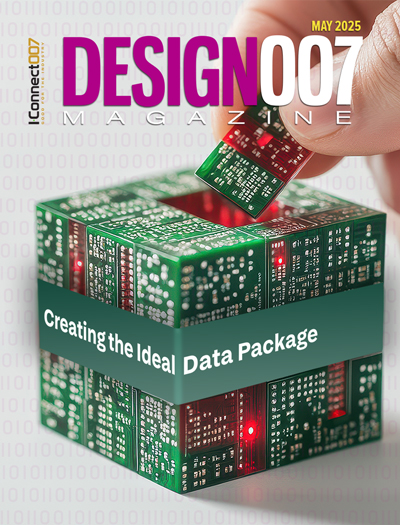-

- News
- Books
Featured Books
- design007 Magazine
Latest Issues
Current Issue
Creating the Ideal Data Package
Why is it so difficult to create the ideal data package? Many of these simple errors can be alleviated by paying attention to detail—and knowing what issues to look out for. So, this month, our experts weigh in on the best practices for creating the ideal design data package for your design.

Designing Through the Noise
Our experts discuss the constantly evolving world of RF design, including the many tradeoffs, material considerations, and design tips and techniques that designers and design engineers need to know to succeed in this high-frequency realm.

Learning to Speak ‘Fab’
Our expert contributors clear up many of the miscommunication problems between PCB designers and their fab and assembly stakeholders. As you will see, a little extra planning early in the design cycle can go a long way toward maintaining open lines of communication with the fab and assembly folks.
- Articles
- Columns
Search Console
- Links
- Media kit
||| MENU - design007 Magazine
Effective Decoupling Radius
May 6, 2015 | Kirk Fabbri, KPST Engineering ConsultingEstimated reading time: 1 minute
Power distribution networks (PDN) are becoming an important topic. Many engineers are finding that properly designing the power supplies and providing adequate decoupling for devices is a challenge, especially since devices are switching faster and dimensions are shrinking. Engineers often focus on discrete decoupling capacitors placed local to switching devices in hopes of providing the required capacitance for these high current demands. One of the more overlooked items of the power distribution system is the PCB, and how it contributes to the power distribution system’s ability to decouple the switching devices. The following experiment will outline a basic principle that should be in mind when designing a stack-up and PDN.
Basic PDN Model
A basic PDN includes the voltage regulator model (VRM), the discrete decoupling capacitors, the PCB, and any on-die capacitance formed on the IC or device. Each one of these components could be written about separately, but it is the PCB that will be focused on; specifically the effective decoupling radius.[2]
When a device is active, it will require current. The type of device (process size), load on the I/O drivers, and how the device is operated, all have an effect on the current required, among others. When the device demands current, it flows through the complex impedance of the PDN and causes a ripple voltage to appear. This transient current is drawn from a variety of sources including the local on-die decoupling capacitance, the PCB, the discrete capacitors, and finally the VRM.[1] The edge rate of this switching current is extremely important when trying to calculate how effective the PDN will be in suppressing the ripple voltage. The switching edge can be dissected into a variety of harmonic sine waves at decreasing amplitude described by a Fourier series equation. It is here that we discover the importance of the PCB, and its role in the PDN.
The simplest way to represent a PCB is a distributed RLC network. Capacitance is formed by the copper layers and the dielectric between them. Inductance is formed by the loop area between the layers, and the resistance is formed by the cross sectional area and length of the copper planes.
To read this article from the April 2015 issue of The PCB Design Magazine, click here.
Suggested Items
RF PCB Design Tips and Tricks
05/08/2025 | Cherie Litson, EPTAC MIT CID/CID+There are many great books, videos, and information online about designing PCBs for RF circuits. A few of my favorite RF sources are Hans Rosenberg, Stephen Chavez, and Rick Hartley, but there are many more. These PCB design engineers have a very good perspective on what it takes to take an RF design from schematic concept to PCB layout.
Trouble in Your Tank: Causes of Plating Voids, Pre-electroless Copper
05/09/2025 | Michael Carano -- Column: Trouble in Your TankIn the business of printed circuit fabrication, yield-reducing and costly defects can easily catch even the most seasoned engineers and production personnel off guard. In this month’s column, I’ll investigate copper plating voids with their genesis in the pre-plating process steps.
Elephantech: For a Greener Tomorrow
04/16/2025 | Marcy LaRont, PCB007 MagazineNobuhiko Okamoto is the global sales and marketing manager for Elephantech Inc., a Japanese startup with a vision to make electronics more sustainable. The company is developing a metal inkjet technology that can print directly on the substrate and then give it a copper thickness by plating. In this interview, he discusses this novel technology's environmental advantages, as well as its potential benefits for the PCB manufacturing and semiconductor packaging segments.
Trouble in Your Tank: Organic Addition Agents in Electrolytic Copper Plating
04/15/2025 | Michael Carano -- Column: Trouble in Your TankThere are numerous factors at play in the science of electroplating or, as most often called, electrolytic plating. One critical element is the use of organic addition agents and their role in copper plating. The function and use of these chemical compounds will be explored in more detail.
IDTechEx Highlights Recyclable Materials for PCBs
04/10/2025 | IDTechExConventional printed circuit board (PCB) manufacturing is wasteful, harmful to the environment and energy intensive. This can be mitigated by the implementation of new recyclable materials and technologies, which have the potential to revolutionize electronics manufacturing.


